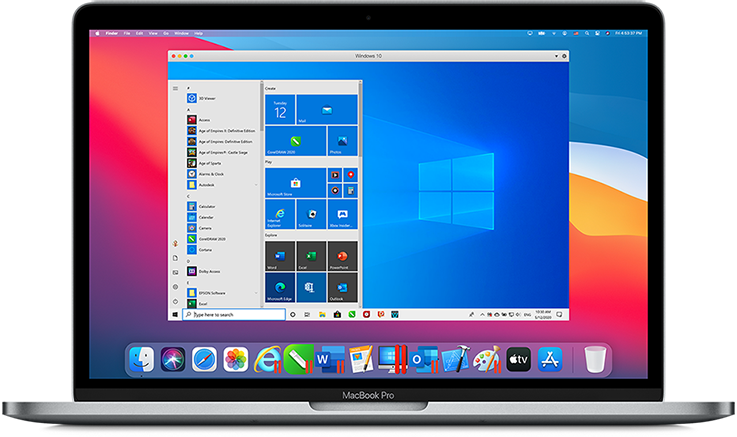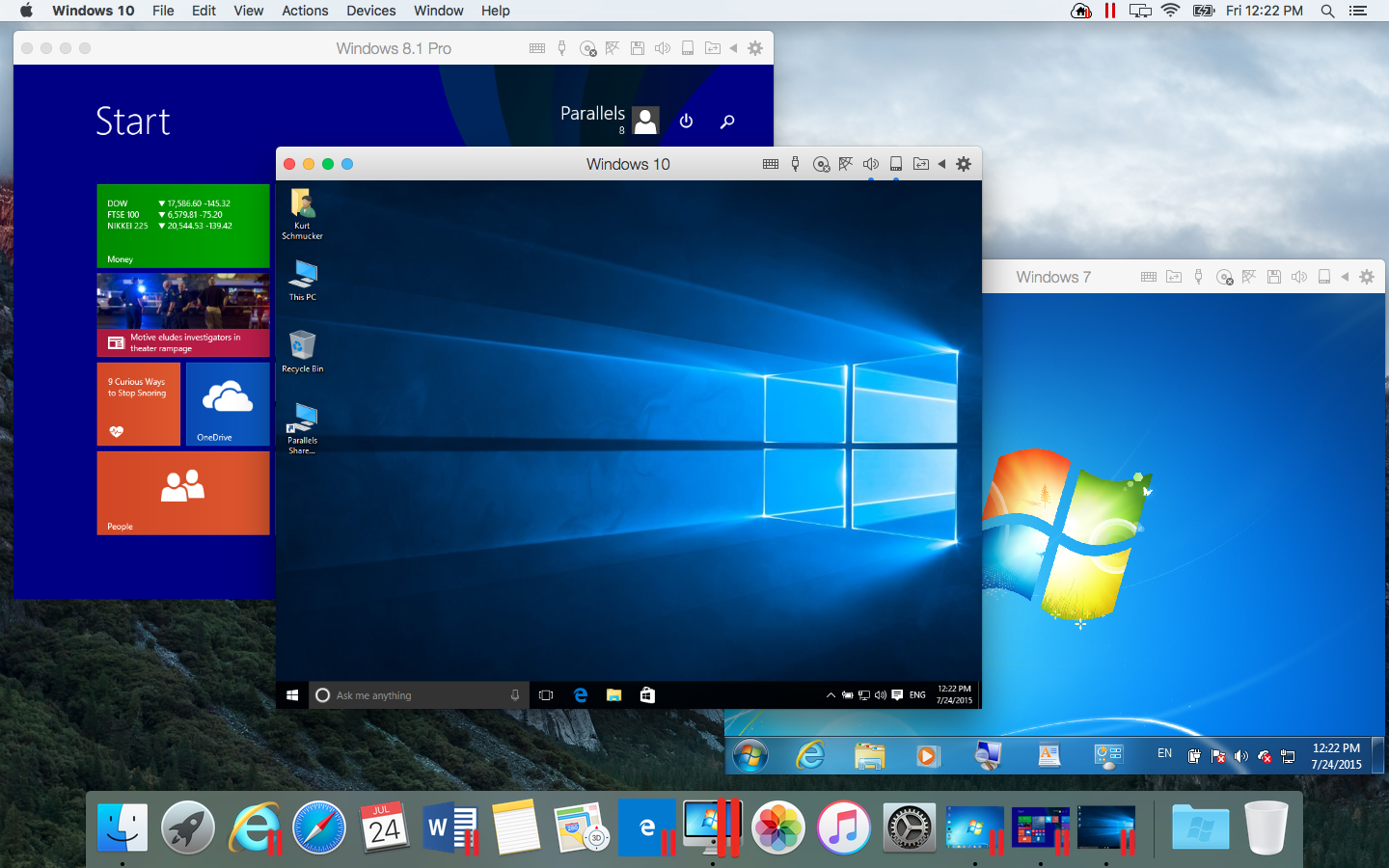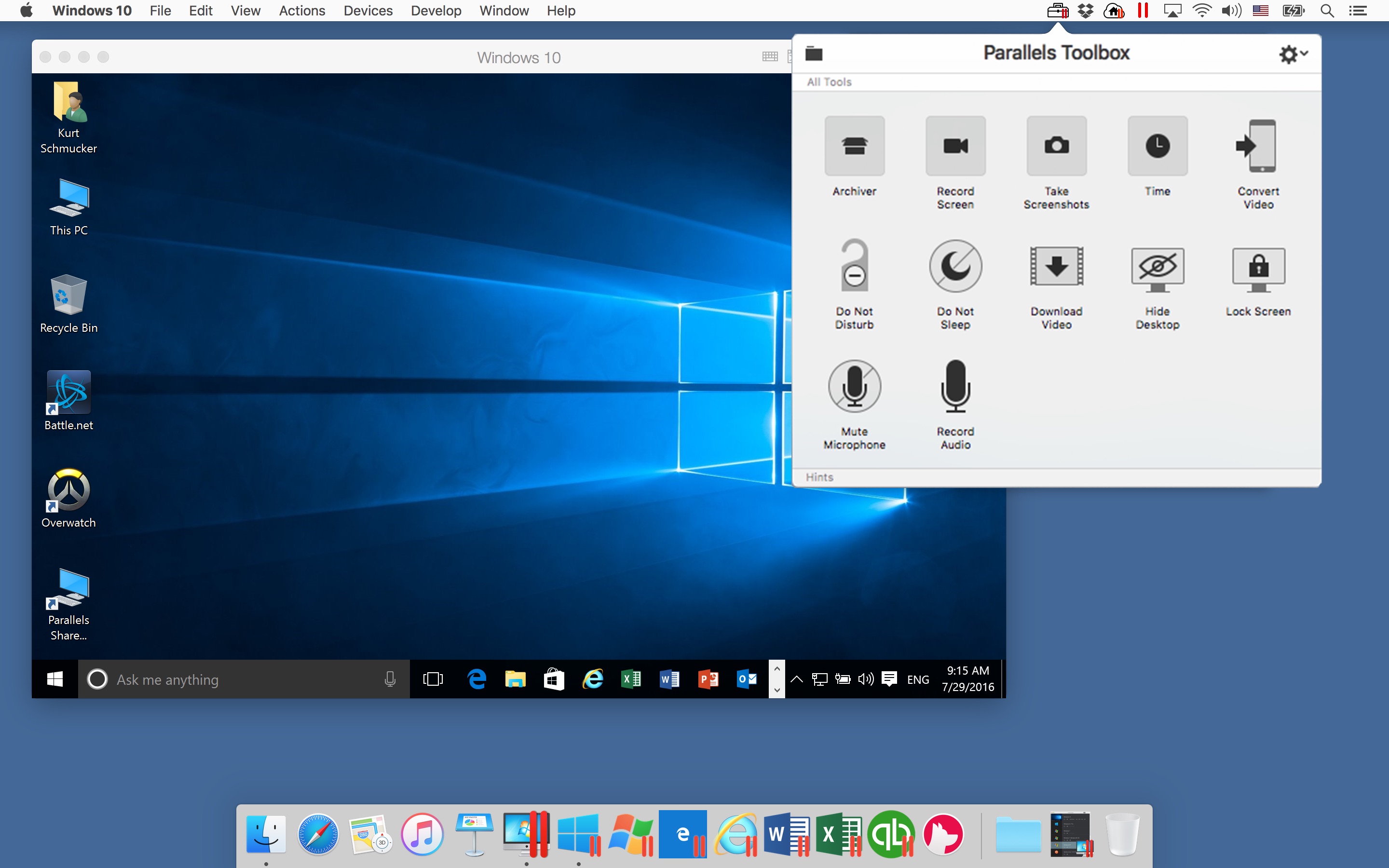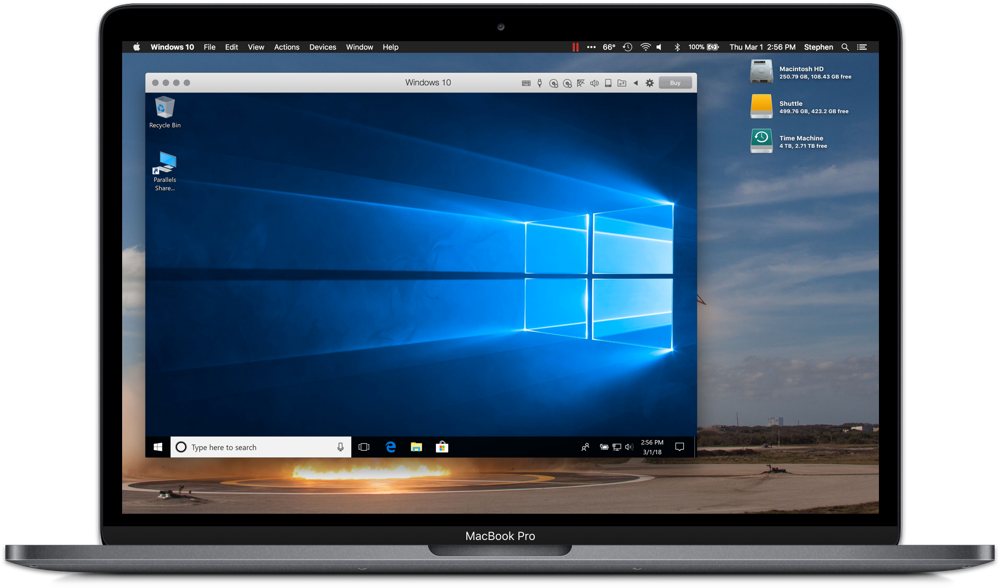Parallels for Mac Free Download: No doubt Apple has done an excellent job of keeping up with its less stylish and more useful companions. Despite you need to access to a Windows system, thanks to the Apple used to say that they have the solution for that.
This video will teach you how to get parallels for free. This will allow you to run operating systems such as Windows on your Mac. Sorry about the Demo Mode.
If you have recently switched from Windows to a Mac, there is the great chance to run some of your windows app. But you will not get the exact match for them in the world of Apple. Even the OS X version of your favorite program may work differently than it does on your windows.
To solve this problem the virtualization utilities like Parallels Desktop are designed to solve. The Parallel desktop and VMware Fusion 8 are the popular virtualization software for OS X. Parallels Desktop 10 for Mac is the most powerful solution for running Windows applications on a Mac. Parallels Desktop for MAC is available with three modes which are given below.
Contents
Buy Parallels Desktop 16 for Mac and get Parallels Toolbox for free! With the new Parallels Desktop 16 for Mac, you can seamlessly use Windows on your Mac, without rebooting. Students and faculty members can get Parallels for 50% off through OnTheHub! Only $39.99 USD / year Faculty & student discount. There are several ways to install Windows (or any other operating system) in a virtual machine, and Parallels Desktop makes it easy to get started within minutes. If you need Windows on your Mac, Parallels Desktop can help you download and install Windows 10. All you need to do is follow our Installation Assistant and click “Install Windows.”. The Official Cyber Monday Mac Bundle Ft. Parallels Pro & Luminar 4 is a collection of 12 apps that can help accelerate your productivity. The collection of apps is valued at $1,266.17, but you can.
Parallels for Mac Free Download
Coherence mode: This mode runs guest and Mac applications side by side in one window.
Full-Screen mode: This mode creates full guest desktop.
Modality mode: You can resize and customize virtual machine windows running on top of the MAC OS.
Benefits of Parallels for MAC
Easy setup: Select your existing Windows, Ubuntu, Linux or Boot Camp for installation Windows 10 on your Mac within Parallels Desktop and started within minutes.
Use Mac application and Windows both: You can keep the familiar Windows background or make Windows invisible while still using its applications and controls your MAC.
Connect various devices: You can connect the USB, FireWire devices and Thunderbolt with Windows. You can pair the Bluetooth and printer to work with both Windows and macOS.
Single click Tuning: Select output, design, games and Parallels Desktop for Mac will optimize your VM setting and performance for you.
Comfortable switching from PC to Mac: Make the switching from PC to Mac easy by following setup assistant. Get all your files, applications, browsers bookmarks and much more from your PC to your Mac.
Excellent performance: The Parallels Desktop for Mac gives your virtual machines more processing power. It runs most demanding applications with up to 128 GB vRAM and 32 vCPU per virtual machine.
How To Install Parallels for Mac
Install Parallel Desktop for Mac in case you are new to Parallels Desktop for Mac, download the latest version. In case you already have a Parallels Desktop user you can proceed the next step.
Download Windows Parallel desktop for Mac 12/13 you can easily download Windows 10 through Parallel Desktop.
Create a new virtual machine from the Application folder and choose New. Click Install windows from the source such as DVD or an image file click continue.
Select the installation media you can install Windows from DVD or a bootable USB drive and .iso disc image.
Enter your Windows product key and click continue: Select the way you want to use the Windows in Parallel the Desktop for Mac in the home edition you can use.
Specify the name and location for your virtual machine, the default location for Parallels Desktop virtual machine is
Users, Username and Parallel: Start the installation by clicking continue and Windows installation will begin. As Windows installed, launch it by opening a Window application or by clicking the Power button in the Parallels Virtual Machine list.
System Requirement for Parallel for Mac
- A Mac computer (Intel Core 2 Duo, Core i5, Core i7, Intel Core M/Xeon processor)
- 4GB of memory (8GB recommended)
- Additional disk space for virtual machines.
- 850 MB of disk space on the boot volume for the installation Parallels Desktop.
- Fast Internet connection for product activation and select features.
- macOS High Sierra 10.13
- macOS Sierra 10.12.5 or advanced
- OS X EI Captain 10.11.6 or advanced
- OS X Yosemite 10.10.5 or advanced
Finally, we can say that Parallel Desktop is an integrated app for running Windows apps or the Windows desktop in Apple OS X. You can choose Parallel for Mac for home, for professionals, Finding The Code and Error developers, small teams and for Business and IT.
5 out of 5
Responsive integrated Windows experience
4.5 out of 5
One-time payment starting $79.99
5 out of 5
Runs like a Mac app (absolutely intuitive)
4.5 out of 5
Multiple ways to contact support
Quick Summary
Parallels Desktop lets you run Windows apps on your Mac. That can be very handy if you rely on certain Windows apps for your business, or have switched to Mac and can’t find alternatives for everything you need.
Is it worth it? If you have Mac apps for everything you need you won’t need Parallels, and if you need just a few non-critical Windows apps a free alternative may meet your needs. But if you rely on Windows apps to get your work done, you’ll need the premium Windows performance that Parallels Desktop provides.
Get Parallels For Mac Free
What I Like- Windows is very responsive
- Pauses when not in use to save resources
- Coherence mode lets you run Windows apps like Mac apps
- Also run Linux, Android and more
- My mouse became unresponsive once
- macOS and Linux are less responsive than Windows
Parallels Desktop for Mac
Quick Navigation
// Why Trust Me?
// Parallels Desktop FAQs
// Parallels Desktop Review: What's in It for You?
// Reasons Behind My Reviews and Ratings
// Alternatives to Parallels Desktop
// Conclusion


Why Trust Me?
My name is Adrian Try. After using Microsoft Windows for over a decade, I made a deliberate move away from the operating system in 2003. I enjoyed the change, but still needed certain Windows apps on a regular basis. So I found myself using a combination of dual boot, virtualization (using VMware and VirtualBox) and Wine. See the Alternatives section of this Parallels Desktop review.
I hadn’t tried Parallels before. I was provided a review license and installed an earlier version on my iMac. For the last week, I’ve been putting it through its paces, installing Windows 10 (purchased just for this review) and several other operating systems, and trying just about every feature in the program.
The new version was released last night, so I immediately upgraded. This review reflects my use of both versions and all of the screenshots are from version 13.
In this Parallels review, I’ll share what I like and dislike about Parallels Desktop. The content in the quick summary box above serves as a short version of my findings and conclusions. Read on for the details!
Parallels Desktop FAQs
What is Parallels Desktop?
It’s an app that allows you to run Windows apps on your Mac. It does this by allowing you to install Windows on a virtual machine — a computer emulated in software. Your virtual computer is assigned a portion of the RAM, processor and disk space of your real computer, so it will be slower and have fewer resources.
Other operating systems will also run on Parallels Desktop, including Linux, Android, and macOS — even older versions of macOS and OS X (El Capitan or earlier).
What’s New in Parallels Desktop 15?
Parallels has added a number of new features to version 15. According to the release notes from Parallels, those include 30+ new features such as macOS Catalina support, full Apple Pencil support in Sidecar, screenshot preview to Windows, and more.
Is Parallels Desktop Safe?
Yes, it is. I ran and installed the app on my iMac and scanned it for viruses. Parallels Desktop doesn’t contain any virus or malicious processes.
Be aware that when you install Windows in Parallels, you become vulnerable to Windows viruses (on the virtual machine and the files it can access), so make sure you protect yourself. A trial version of Kaspersky Internet Security is included, or install your security software of choice.
During my use of the app, my mouse froze once when switching between Windows and Mac. This required a reboot to fix. Your mileage may vary.
Is Parallels Desktop Free?
No, it isn’t freeware though a full-featured 14-day trial is available. There are three versions of the app to consider.
- Parallels Desktop for Mac ($79.99 for students): Designed for home or student use.
- Parallels Desktop for Mac Pro Edition ($99.99/year): Designed for developers and power users who need the best performance.
- Parallels Desktop for Mac Business Edition ($99.99/year): Designed for IT departments, it includes centralized administration and volume licensing.
- You’ll also have to pay for Microsoft Windows and your Windows applications if you don’t already own them.
How to Install Parallels Desktop for Mac?

Here is an overview of the full process of getting the app up and running:
- Download and install Parallels Desktop for Mac.
- You’ll be asked to choose an operating for your new virtual machine. To install Windows, you have three choices: purchase it online, install it from a US stick, or transfer it from a PC. Enter the Windows product key when prompted.
- Windows will be installed along with some Parallels tools. This will take some time.
- Your new Windows desktop will be displayed. Install any Windows application software you need.
Parallels Desktop Review: What’s in It for You?
Since Parallels Desktop is all about running Windows apps (and more) on your Mac, I’m going to list all its features by putting them into the following five sections. In each subsection, I’ll first explore what the app offers and then share my personal take.
1. Turn Your Mac Into Several Computers with Virtualization
Parallels Desktop is virtualization software — it emulates a new computer in software. On that virtual computer you can run any operating system you like, including Windows, and any software that runs on that operating system. That’s very convenient if you need non-Mac software.
A virtual machine will run slower than your real computer, but Parallels has worked hard to optimize performance. But why run a slower virtual machine when you can install Windows on your actual computer using Bootcamp? Because having to restart your machine to change operating systems is slow, inconvenient, and incredibly frustrating. Virtualization is an excellent alternative.
My personal take: Virtualization technology provides a convenient way of accessing non-Mac software while using macOS. If you need regular access to Windows apps, Parallel’s implementation is superb.
2. Run Windows on Your Mac Without Rebooting
You may need to run Windows on your Mac for a variety of reasons. Here are some examples:
- Developers can test their software on Windows and other operating systems
- Web developers can test their websites on a variety of Windows browsers
- Writers can create documentation and reviews about Windows software.
Parallels provides the virtual machine, you need to supply Microsoft Windows. There are three options:
- Purchase it directly from Microsoft and download it.
- Purchase it from a store and install from a USB stick.
- Transfer Windows from your PC or Bootcamp.
Transferring a previously-installed version of Windows is the least-recommended option, as it can lead to licensing issues or driver problems. In my case, I purchased a shrink-wrapped version of Windows 10 Home (with USB an enclosed USB stick) from a store. The price was the same as downloading from Microsoft: $179 Aussie dollars.
I started up Parallels Desktop, inserted my USB stick, and Windows was installed without fuss.
Once installed, Windows feels snappy and responsive. Moving from Windows to Mac and back again is fast and seamless. I’ll explain how that’s done in the next section.
My personal take: For those needing access to Windows while using macOS, Parallels Desktop is a godsend. They have obviously worked hard to optimize their software for Windows, as it is incredibly responsive.
3. Switch Conveniently between Mac and Windows
How easy is switching between Mac and Windows using Parallels Desktop? You don’t even notice it. By default it runs inside a window like this.
When my mouse is outside of that window, it is the black Mac mouse cursor. Once it moves inside the window, it becomes the white Windows mouse cursor automatically and instantly.
For some uses that can feel a little cramped. Pressing the green Maximize button will make Windows run full screen. The screen resolution adjusts automatically. You can switch to and from Windows using a four-finger swipe.
Very fast, very easy, very intuitive. Switching between Mac and Windows couldn’t be easier. Here’s another bonus. For convenience, I found myself leaving Windows open even when I wasn’t using it. When not in use, Parallels pauses the virtual machine to reduce the load on your computer.
Once your mouse enters the Windows environment again, Windows is up and running again within about three seconds.
My personal take: Whether running Windows full-screen or in a window, switching to it is simple and seamless. It’s no harder than switching to a native Mac app.
4. Use Windows Apps alongside Mac Apps
When I first moved away from Windows, I found myself still relying on a few key apps. You might be the same:
- You switched to Mac, but still have a number of Windows apps you rely on — perhaps the Windows versions of Word and Excel, the Xbox Streaming app, or a Windows-only game.
- You may still absolutely depend on a legacy app that no longer works on modern operating systems.
It’s surprising how reliant businesses can become on out-of-date software that is no longer updated or supported. Parallels Desktop provides a Coherence Mode which lets you work with Windows apps without dealing with the Windows interface. David Ludlow sums it up: “Coherence turns your Windows apps into Mac ones.”
Coherence Mode hides the Windows interface altogether. You launch the Start Menu by clicking the Windows 10 icon on your dock.
You can search for and run the Windows Paint program from Spotlight.
Paint runs right on your Mac desktop, no Windows in sight.
And the Mac’s right-click Open With menu even lists Windows apps.
My personal take: Parallels Desktop allows you to use Windows apps almost as if they were Mac apps. You can start the apps from your Mac’s Dock, Spotlight, or a context menu.
5. Run Other Operating Systems on Your Mac

The convenience of Parallels Desktop doesn’t stop with Windows. You can run a variety of operating systems, including Linux, Android and macOS. Why would someone want to do that? Here are some examples:
- A developer working on an app that runs on multiple platforms can use virtual computers to run Windows, Linux and Android to test the software on.
- Mac developers can run older versions of macOS and OS X to test compatibility.
- A Linux enthusiast can run and compare multiple distros at once.
You can install macOS from your recovery partition or a disk image. You can also install older versions of OS X if you still have the installation DVDs or disk images. I chose to install macOS from my recovery partition.
I found macOS significantly less responsive than Windows — I assume Parallel’s main priority is Windows performance. It was definitely usable, though.
Installing Linux is similar. You can either choose to have Parallels Desktop download a number of Linux distros (including Ubuntu, Fedora, CentOS, Debian and Linux Mint), or install from a disk image.
Like macOS, Linux seems less responsive than Windows. Once you have a few operating systems installed, the Parallels Desktop Control Panel is a handy way to start and stop them.
My personal take: Parallels Desktop can run macOS or Linux on a virtual machine, though not with the same speed as Windows, or with as many integration features. But the software is stable and usable all the same.
How To Get Parallels For Mac Free
Reasons Behind My Reviews and Ratings
Effectiveness: 5/5
Parallels Desktop does exactly what it promises: it runs Windows apps alongside my Mac apps. Running Windows in a virtual machine was convenient and responsive, and allowed me to access Windows apps that I rely on. Windows paused when not in use, so unnecessary resources were not being wasted.
Price: 4.5/5
Although there are free virtualization options, $79.99 is a reasonable price to pay for the amount of work Parallels have put into optimizing performance and integration.
Ease of Use: 5/5
I found launching Windows and switching between Mac and Windows absolutely intuitive. The integrated approach of displaying Windows software in Spotlight searches, context menus and the Dock is brilliant.
Support: 4.5/5
Free support is available via Twitter, chat, Skype, phone (Click-to-Call) and email for the first 30 days after registering. Email support is available for up to two years from the product release date, though you can purchase phone support when required for $19.95. A comprehensive knowledge base, FAQ, Getting Started guide and User’s Guide are available.
Alternatives to Parallels Desktop
VMware Fusion 8.5: VMware Fusion ($79.99) is Parallel Desktop’s closest competitor, and is a little slower and more technical. A major upgrade is about to be released.

Veertu Desktop: Veertu (free, $39.95 for premium) is a lightweight alternative. It’s almost as quick as Parallels, but has fewer features.
VirtualBox: VirtualBox is Oracle’s free and open source alternative. Not as polished or responsive as Parallels Desktop, it’s a good alternative when performance is not at a premium.
Boot Camp: Boot Camp comes installed with macOS, and allows you to run Windows alongside macOS in a dual-boot setup — to switch you need to restart your computer. That’s less convenient, but has performance benefits.
Wine: Wine is a way of running Windows apps on your Mac without needing Windows at all. It can’t run all Windows apps, and many require significant configuration. It’s a free (open source) solution that just might work for you.
CrossOver Mac: CodeWeavers CrossOver ($59.95) is a commercial version of Wine that is easier to use and configure.
Conclusion
Parallels Desktop runs Windows and other operating systems in a virtual machine alongside your Mac apps. It’s a good option for those who still rely on certain Windows apps for their business, or gamers who can’t live without a favorite Windows game. It’s also a great solution for developers who need to test their apps or websites on other platforms.
If you’ve found native Mac apps that meet all of your needs, you don’t need Parallels Desktop. If you need to run just a handful of non-critical Windows apps, one of the free virtualization alternatives may be all you need. But if you’re looking for best performance, Parallels Desktop is your best option. I highly recommend it.
